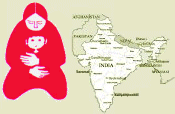Okay… This is another “slightly circular” approach to this week’s PhotoHunter theme. HA! A puzzle AND a pun!
 In 1837 and 1838, Canada was the scene of a number of rebellions. Rebellions were fought in both Upper and Lower Canada during this two year period.
In 1837 and 1838, Canada was the scene of a number of rebellions. Rebellions were fought in both Upper and Lower Canada during this two year period.
In the British colony of Upper Canada (Upper Canada being the region of Canada lying “up the St, Lawrence”, generally Eastern and Southern Ontario), was brought about by the efforts of William Lyon Mackenzie a reformer, newspaper editor, Mayor of Toronto, and orator who had for many years been trying to bring about reform of the government of Ontario. In 1837, he gave up on a peaceful means of achieving this goal and rallied both radicals and moderates to overthrow the government.
This rebellion, known as The Upper Canada Rebellion, was rapidly quashed and William Lyon Mackenzie and many of his followers absconded to the United States. More than 800 followers were arrested. Some were granted amnesty, two leaders were hanged for treason, and some two dozen were “transported” to a penal colony in Australia.
Some of the rebels banded together with American supporters who saw the prospect of overthrowing the British government in Upper Canada as a chance to expand America into the region.
In December 1837, they launched a raid which led to their occupation of Navy Island (a small island in the Niagara River which they proclaimed “The Republic of Canada” from which they were eventually expelled and William Lyon Mackenzie fled to the US).
A skirmish at Short Hills in the Niagara peninsula, in June 1838, The Battle of the Windmill, in November; and a series of bloody and violent raids in the Windsor/Detroit area, in December, followed. Large numbers of British regulars and Upper Canada militia repulsed the raids, 15 rebels were hanged and several dozen more were transported to Tasmania, into penal servitude.
On November 12, 1838, a group of American raiders (calling themselves Patriot Hunters) and Canadian rebels made an attempt to land on the Canadian side of the St. Lawrence River. in order to take the town of Prescott, side of Fort William. They were driven back that night. Convinced that this force of about 250 men would be quickly joined by hundreds of discontented Canadians, the undeterred force tried another landing point at Windmill Point, some miles east of Prescott.
Sadly, their mistaken belief that some (or, indeed, ANY) Canadians would join them led to the bloody and tragic event called the Battle of the Windmill.
Certainly, the Windmill was an ideal place (seemingly) to choose to base their attack on Upper Canada. The invaders, under the command of Nils von Schoultz, were well equipped with ammunition to last 4 to 5 days. The Windmill was a strong defensive point and would have afforded them an excellent vantage point and the British could not approach unobserved. This, and their certainty in drawing local supporters to their cause, led them to believe they would win handily.
The British quickly gathered a small group of local militia and regular troops in Prescott and, with the support of guns from steamers plying the waters of the St. Lawrence, on November 13th they made their approach to the Windmill.
Even with a superior force of some 600 men, it was not to be an easy victory for the British and Upper Canadians. The fighting went on for some 5 bloody hours, during which 13 British soldiers were killed and 78 wounded. The “Hunters” were believed to have lost 18, 20 wounded, and 26 captured.
By the 14th and 15th, the Hunters were running low on ammunition and food, and had suffered heavy losses. Reinforcements from Ogdensburg (on the American side of the river) had not appeared and neither had all those supposedly discontented Canadians.
On the 16th, the Americans must have been terrified. More and better armed steamers had arrived…. and a force of 1000 British and Canadians were preparing for the second attack on the Windmill. At 3:30 in the afternoon, the bombardment from the artillery by land and on the river, began. Some of the Hunters surrendered but others put up a futile fight. By 6:00, the Americans were defeated. Some surrendered while others melted off into the gathering darkness. Some 50 were laid in common graves near the battle-site. Many were captured and tried.
“The process of trials and punishments required many months to complete. There were few acquittals (40), and relatively few executions (11, including Nils von Schoultz). 60 were convicted and transported to a British penal colony in Australia. 86 were condemned, but later pardoned and released to return to their homes.”
The Battle of the Windmill was a crucial victory for Upper Canada. Had the Americans and the Canadian rebels taken Prescott and the fort which protected the St. Lawrence River, they would have essentially cut the throat of Upper Canada and left it open to invasion from the south.
However, we LICKED them…







